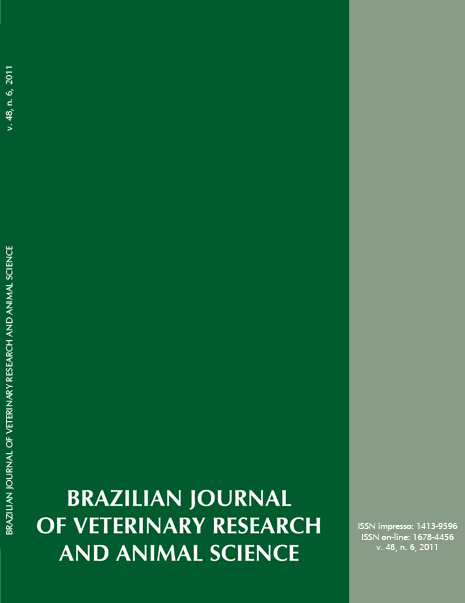Clinical evaluation of hypertonic saline solution treatment for acute ruminal lactic acidosis on cattle
DOI:
https://doi.org/10.11606/S1413-95962011000600002Keywords:
Hypertonic, Dehydration, Acidosis, Lactic, Ruminal, CattleAbstract
Hypertonic saline solution (HSS) is known as an important treatment for hypovolemic shock. Cattle with acute rumen lactic acidosis (ARLA) usually present different degrees of dehydration. This study evaluated the efficiency of HSS for treatment of ARLA. Twelve yearling, cross-bred, male cattle were used. After an adaptation period, when a rumen cannula was implanted, the animals were submitted to an induction of ARLA by the administration of sucrose into the rumen. Twenty hours later the cattle were randomly divided in two groups. The 1st group was treated with 5 mL/kg BW with 7.5 % (NaCl), within 15 min after 20th h of the induction; thereafter it was infused 20 mL/ kg BW of isotonic saline solution (ISS) for the next 165 min. The 2nd group was treated only with ISS. Five liters of ruminal contents were removed and replaced with five liters of water in both groups. Variables were measured at time 0 (MO), 20 h (M20h) and throughout the treatment (M30', M60', M120' e M180'). The use of HSS caused a mild acidemia followed by a discrete hypercapnia. No side effects were seen in cattle treated with HSS. Infusion of HSS decreased the globular volume indicating a passage of fluids from the rumen into the bloodstream, correcting partially the dehydration. The use of HHS is a possible additional treatment for correction of dehydration caused by ARLA.Downloads
Download data is not yet available.
Downloads
Published
2011-12-01
Issue
Section
UNDEFINIED
License
The journal content is authorized under the Creative Commons BY-NC-SA license (summary of the license: https://
How to Cite
1.
Rodrigues FAML, Minervino AHH, Barrêto Júnior RA, Antonelli AC, Reis LF dos, Araújo CASC, et al. Clinical evaluation of hypertonic saline solution treatment for acute ruminal lactic acidosis on cattle. Braz. J. Vet. Res. Anim. Sci. [Internet]. 2011 Dec. 1 [cited 2025 Mar. 11];48(6):446-53. Available from: https://revistas.usp.br/bjvras/article/view/34351





